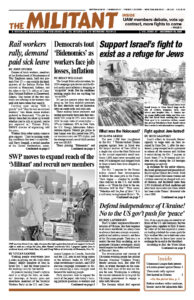Ten years ago, on Dec. 6 and 8, 2013, tens of thousands of workers and other Ukrainians from all over the country rallied in Kyiv, the country’s capital, joining the battle to oust the pro-Moscow government of Viktor Yanukovych. The powerful mobilizations came in response to bloody riot police assaults on student demonstrators a week earlier, setting off two months of mass mobilizations and battles in the streets.
By early 2014 that became hundreds of thousands of working people across Ukraine as the fight deepened. Tents and barricades sprang up near the Trade Union House building in Kyiv’s Independence Square, giving the “Revolution of Dignity” its popular name, the Maidan.
Behind the depth of these mobilizations lay the national aspirations of the Ukrainian people, who — with the exception of the early years of the Russian Revolution under V.I. Lenin when the Ukrainian language and culture flourished — have chafed under, and resisted, centuries of Russian domination. This stretched from the czars’ “prison house of nations” to the counterrevolutionary Stalin years to Vladimir Putin’s war today.
The Maidan revolution succeeded in overthrowing Yanukovych Feb. 21. Russian President Vladimir Putin reacted by using Russia’s military base in Crimea to seize the peninsula, putting down both the widespread pro-Ukrainian sentiment and the national aspirations of the indigenous Crimean Tatars. Next he sent agents and troops to work with separatists to assault and occupy parts of Ukraine’s Donetsk and Luhansk provinces.
In February 2022 Putin launched a full-scale invasion of Ukraine, claiming his troops would be welcomed as saviors and Kyiv would fall within three days. He said the idea of Ukrainians as a separate nationality was a fraud and he would be recognized as a new Russian czar.
The scale of resistance by working people today can only be understood by looking back at the Maidan revolution and the way it strengthened the Ukrainian working class.
The Socialist Workers Party responded to the Maidan by sending three Militant reporting teams over the next year to meet and learn from the fighters involved. Militant editor John Studer met with coal miners, nuclear workers at Chernobyl and Enerhodar, rail workers and many other defenders of Ukrainian sovereignty, from Sokal in the west to Pavlograd in the east, to iron-ore miners in Kryvyi Rih, steelworkers in Dnipro and transit workers in Kharkiv.
The Militant has been able to lead in getting out the truth about and defending the Ukrainian people’s battle for independence. It also reports on struggles by the country’s working people in their own class interests.
Its firsthand coverage gives the lie to the Putin regime’s claim the Maidan was a U.S.-backed “Nazi” coup. Moscow’s propaganda lies from then till now, supported by much of the middle-class left, are wearing thin inside Russia itself where working-class opposition to his war on Ukraine is spreading.
“We are a sovereign nation,” coal miner Yura Sheremeta told Studer in April 2014 in Chervonograd, western Ukraine. “We have spirit and we will continue to fight. If we don’t succeed this time, we will have another Maidan. And I think there will be one in Russia too.”
In coming issues the Militant plans to run regular features based on these trips to Ukraine and developments in the class struggle since.

